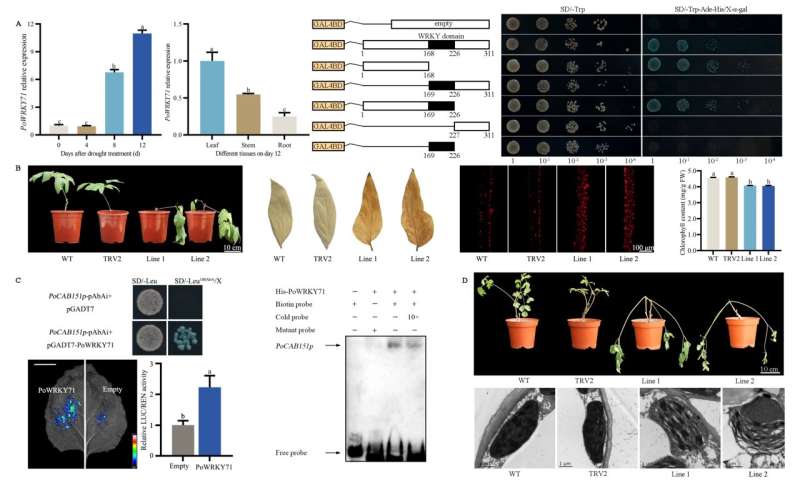This article has been reviewed according to Science X's editorial process and policies. Editors have highlighted the following attributes while ensuring the content's credibility:
fact-checked
peer-reviewed publication
trusted source
proofread
Scientists analyze the molecular mechanism of PoWRKY71 in response to drought stress in Paeonia ostii

Paeonia ostii is a widely grown woody crop with up to 40% α-linolenic acid in its seed oil, which is beneficial to human health. Drought is a major environmental factor limiting the popularization of P. ostii in hilly and mountainous areas, which may affect plant growth or lead to plant death.
WRKY is one of the largest families of transcription factors in plants, and plays an important role in plant response to drought stress. However, the molecular mechanism by which P. ostii WRKY transcription factors respond to drought stress is still unclear.
In September 2023, Horticulture Research published a research paper by Professor Tao Jun's team at Yangzhou University entitled, "PoWRKY71 is involved in Paeonia ostii resistance to drought stress by directly regulating light-harvesting chlorophyll a/b-binding 151 gene."
In order to analyze the molecular regulation mechanism of WRKY transcription factors in response to drought stress in P. ostii, the study screened a WRKY family transcription factor PoWRKY71 based on the previous transcriptome, which positively regulated drought stress.
It was found that PoWRKY71 expression was induced by drought stress, and PoWRKY71 was localized in the nucleus and possessed transcriptional activation activity.
Next, the gene functional analysis study revealed that transient silencing of PoWRKY71 in P. ostii significantly reduced the drought tolerance of the plants, and the transgenic lines showed a significant increase in ROS accumulation and a significant decrease in chlorophyll content and photosynthesis; while overexpression of PoWRKY71 in tobacco significantly enhanced the drought tolerance of the plants, and the transgenic lines showed a significant decrease in ROS accumulation and a significant increase in chlorophyll content and photosynthesis.
Further screening of genes related to chlorophyll biosynthesis and homeostasis regulation revealed that the expression of PoCAB151, a light-harvesting chlorophyll a/b-binding protein gene, was significantly down-regulated in the silenced plants, and it was clear from the Y1H, EMSA, and dual-luciferase experiments that PoWRKY71 could directly bind to PoCAB151 promoter and activate its expression.
In addition, VIGS and overexpression techniques identified that PoCAB151 positively regulated the chloroplast homeostasis and drought tolerance in P. ostii.
In summary, this study reveals a new working model of PoWRKY71-PoCAB151 regulating drought tolerance of P. ostii, which provided an important reference for plant drought resistance breeding.
More information: Yuting Luan et al, PoWRKY71 is involved in Paeonia ostii resistance to drought stress by directly regulating light-harvesting chlorophyll a/b-binding 151 gene, Horticulture Research (2023). DOI: 10.1093/hr/uhad194
Journal information: Horticulture Research
Provided by NanJing Agricultural University





















